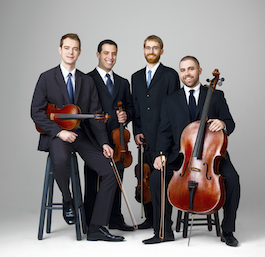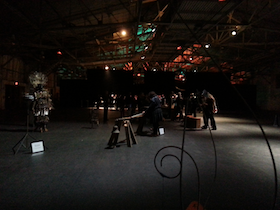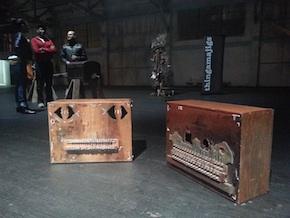
At the cold and foggy end of a warehouse-like Fort Mason pier, with seagulls chiming in throughout the evening, the Sweet Thunder Electro Acoustic Music Festival kicked off this Thursday with a concert by the JACK Quartet. None of the music presented this evening would be defined as music in the mainstream sense. In the world of academic new music, if the melody is naturally singable it is considered cliche; triadic harmony is practically forbidden; regular metered time is only quoted in nostalgic snippets, never as a steady basis. Instead, these composers relish the intricate chaotic complexity of what we normally dismiss as noise. Extended technique is the name of this game, made palatable by a dash of reverb and delay in the electronics.
The JACK Quartet (an acronym of the performers first names; John Pickford Richards, viola, Ari Streisfeld, violin, Christopher Otto, violin, and Kevin McFarland, cello) looks totally comfortable with any aspect of extended technique, and then some. There was a lot more music played behind the bridge, on the bridge, or over the fingerboard, rather than what the violin was designed for — playing between the bridge and fingerboard. There was also quite a bit of playing on the wood of the instrument.
In Nightmare for JACK (a ballet) by Natacha Diels the performers were asked to jerk their necks in rhythmic jabby motions, to mumble buzzed fast-forward-speech-like sounds, play the glockenspiel, hit water glasses with delicate mallets, and then draw the bow across the lips of the glasses, resulting in a grainy abrasive texture. Exploring these new sounds, finding interest in them, and arranging them into thoughtful compositions is an ear and mind-opening experience. Whether due to the conditioning of growing up listening to harmony based on the physical overtone series and rhythms based on a regular steady beat, or due to the our innate amenability to these natural mathematical patterns, music that consciously avoids these patterns made me feel uneasy. The extra-musical subject matter of the compositions reflects this sentiment.

Kevin Ernste’s Palimpsest, which according to the program note refers to “a manuscript whose original text has been scraped or washed away and overwritten with a new one” featured more extended-technique scraping, lots of harmonics, setting a skittish texture for distorted snippets of music by Ravel, Schoenberg, Dowland, and others, or speech clips by John Cage. It captured the inner world of the composer — all kinds of sounds and challenging ideas flowing in and out while centuries of musical history resonate in distant chambers of the brain.

Photo by Be'eri Moalem
In each of the first three pieces, the composers sat at the soundboard helm, adjusting volumes, tweaking intensity of electronic effects, and triggering sound samples — almost as members of the ensemble. Throughout the evening, while trying to digest the extended-technique sounds, my ear yearned for some smooth legato sound and some expressive vibrato. Are the composers of academia so tired of the traditional violin sounds that legato has become taboo? Jonathan Harvey’s String Quartet No. 4 again patiently explores every conceivable way of playing the string instrument.
I thought the string quartet concert would end without any normal playing. But after almost half an hour of restraint, in the last minutes of the piece, Harvey allows for the instruments sing they way they were designed to. After abstaining from this sound for so long, the JACK Quartet opened up for some beautiful romantic harmonies and melodic counterpoint for a blissful if fleeting moment — the brief musical orgasm quickly dissipated into the stratospheric reaches of the instruments.
The festival continues throughout the weekend with performances by the San Francisco Contemporary Music Players, the International Contemporary Ensemble with music by Morton Subotnick, Karlheinz Stockhausen, Edgard Varése, and many others. Installed in the middle of the pier is “music for people & thingamajigs,” in which the audience is invited to try out fantastical and unique inventions. There was a marimba arranged a hexagon, a cage with locks and keys for percussion, a long horn for anyone to blow, a tribal-looking costume with bones and shells clinking together, and a guitar with sympathetic strings arranged in a conch shape swirl pattern, just to name a few of the artifacts that please both the ears and the eyes. The chaotic yet pleasant sound of people experimenting with and talking about these instruments during intermission was a highlight of the concert.

